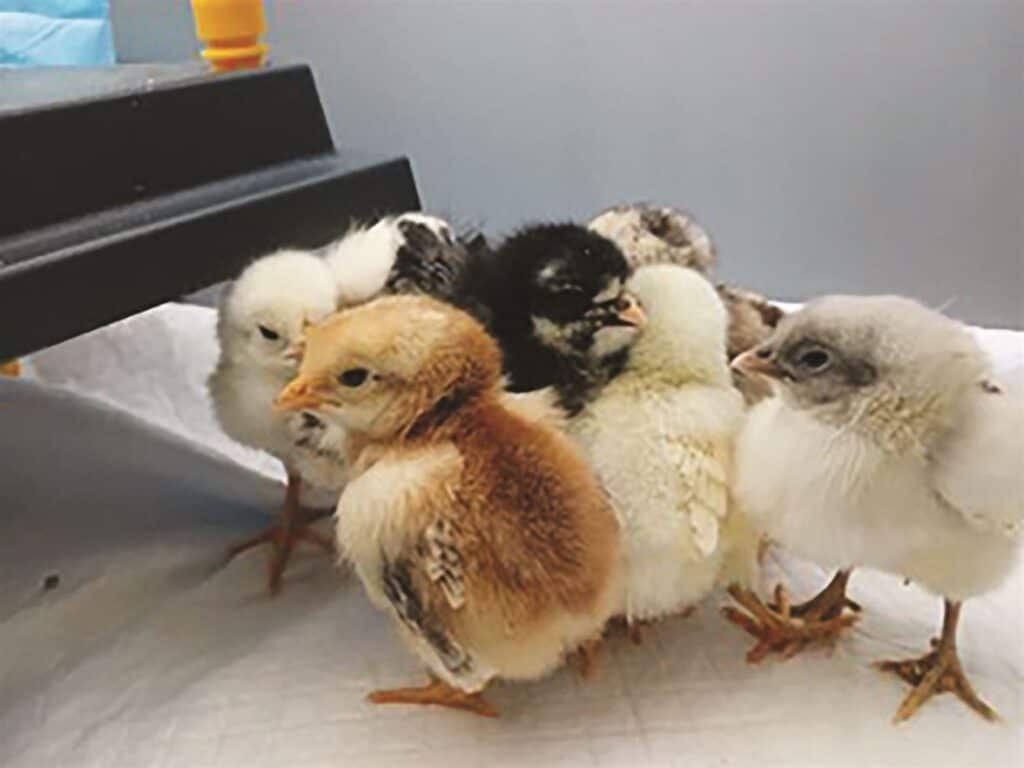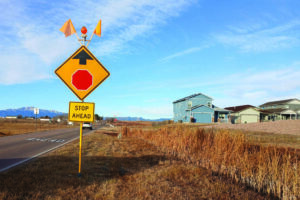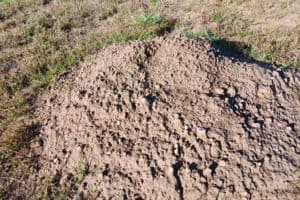Longtime local journalist Bill Radford and his wife, Margaret, live on 5 acres in the Falcon area with chickens, rabbits, dogs, cats, a flock of parakeets, goats and two horses. Contact Bill at billradford3@gmail.com.
Baby chicks take over our home office
By Bill Radford
There’s been a lot of peeping going on. Call it the summer of the chicks.
First came an encounter between my wife and a woman in Colorado Springs who was selling a set of file cabinets. Margaret bought them, and she and the woman somehow got into talking about chickens; the woman has backyard chickens. She had a hen who was broody and she lamented that it would not have a chance to have babies; as she lived in the city where roosters are not allowed, any eggs her hens laid would not be fertile.
On the other hand, we have two roosters. So Margaret donated a half-dozen of our presumably fertile eggs for the hen to sit on; she ended up with three chicks; and, by all accounts, has been a great mom. I don’t know that we will ever meet our grandchickens, as Margaret calls them, but the grateful woman did give her a bunch of plants for our garden in return.
Next came a favor for a friend, Stephanie Gagnepain, who we know as “The Chicken Lady.” She raises several breeds of chickens, including exotic ones. She needed us to watch over a batch of chicks while she was out of town for a week. So we set the 10 chicks up in a tub in our home office. These were not little fluff-ball chicks, but more like rowdy teenagers who could have used more room. They were also messy, creating a stink in the room through their spreading of dust.

“Chicken dust can drive you crazy,” VJP Poultry (vjppoultry.com) states online. “It is that fine white powder that works its way into every crevice and surface it can find. If you keep brooder chicks in your house, you will find chicken dust all over your home.”
Bedding, food and dry chicken poo all contribute to the dust, but VJP Poultry says the No. 1 cause is chicken dander — microscopic flakes of dried dead and shed skin. “Because chicks grow quickly, their skin cells are constantly turning over and shed off of their bodies.”
So by the time the chicks went back to their place, our home office was indeed coated in chicken dust. By the time we got it clean, it was time for another batch of chicks, this time ours. We had gotten a couple of Swedish flower hens from Stephanie, and they had likely mated with some Indo gigantes, so Margaret had gathered some of their eggs, along with a few from other hens, in an attempt to get some distinctive-looking chicks. (Margaret likes the colorful Swedish flower hens, a rare breed native to Sweden, for their appearance, while the Indio gigante is intriguing because of its size; the species was developed in Brazil and the average hen is nearly 3 feet tall.) Margaret then had another set of friends, who raise chickens commercially for eggs and meat, watch over those eggs in their incubator until they hatched. We provided a dozen eggs and seven hatched. Then the newborn chicks came to our house — and, of course, the home office.
These chicks were smaller and thus less messy, but still produced that pesky chicken dust. By the time they were getting to their unwieldy teenage period, we were able to move them into an enclosure in the garage. The next step, when they are big enough, will be to introduce them to the rest of the chickens.
If we end up with even more roosters, we’ll likely have to set up separate quarters so they don’t fight, or find new homes for them. And that could be a challenge, as my Facebook feed always has people seeking homes for their unwanted roosters.
One risk to raising your own chicks is you can end up with roosters; an earlier time when we let a broody hen hatch a collection of eggs that initially had gone unnoticed, that resulted in two roosters — one we found a home for and the other largely peacefully coexists with our very first rooster, his dad. But if we end up with even more roosters, we’ll likely have to set up separate quarters so they don’t fight, or find new homes for them. And that could be a challenge, as my Facebook feed always has people seeking homes for their unwanted roosters. (I wrote once about a rooster rescue that will take in your rooster only if you stop raising chickens so that you don’t continue to contribute to the rooster problem; roosters in a commercial egg-laying setting typically meet a gruesome fate at a young age.)
At any rate, we will have added to our chicken population, though the new hens probably won’t start producing eggs until Halloween or so. That’s about the time our chickens largely quit laying for the winter months; we’ve talked about providing some artificial lighting through the dark winter to keep them laying, but so far have never gotten around to it. Perhaps the bigger worry is if we end up with some half-Indio gigantes. Will I need to make the chicken door to their coop bigger?
In the meantime, the home office now seems oddly quiet without the constant peeping. But on the plus side, it’s dust-free.





